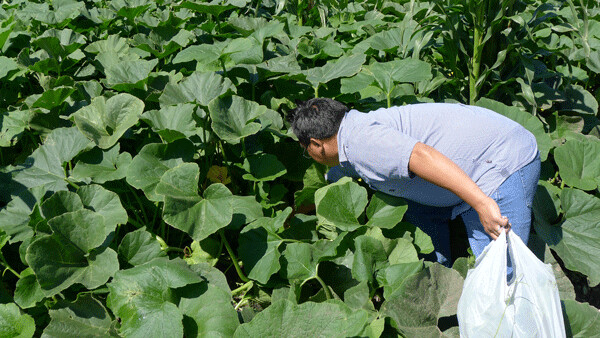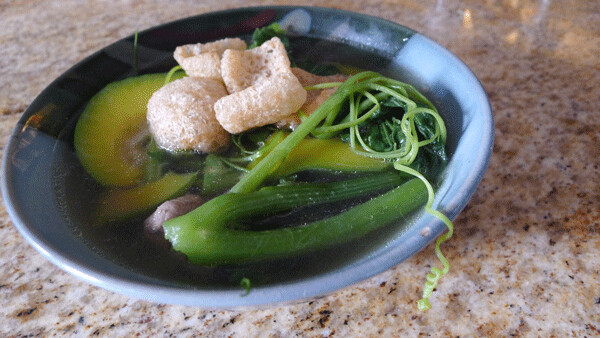Everything but the roots

When Americans get excited about squash, it isn't usually for the stems. We eat the fruits - thin-skinned zucchini or hardened winter squashes - and sometimes we eat the squash blossoms. But the rest of the plant is edible, too, including the broad fuzzy leaves, prickly stems and curlicue climbing tendrils. Indeed, many cultures around the world prize these itchy, scratchy plant parts.
Greens from any summer or winter squash are fair game, but the most delectable portions are found at the tip of each vine branch. This is where plant cells are actively dividing and differentiating into new buds, leaves, tendrils and shoots. It's the most tender region to eat, and easiest to prepare.
I learned the ways of squash greens from a grower named Chia, who does a brisk business in bunched squash greens, among other, more recognizable crops, at my local farmers market. Born in Laos, Chia is a member of the Hmong ethnic group, which drifted into Southeast Asia from southern China over the course of two centuries. Hmong soldiers allied with the United States during the Vietnam War, helping American soldiers navigate the nearly impenetrable, jungle-covered hills that link Vietnam, Cambodia and Laos. When the war ended, the U.S. welcomed hundreds of thousands of Hmong to resettle here.
The largest Hmong populations are in California, Minnesota and Michigan. The small population where I live in Western Montana numbers only in the hundreds, and is a tight-knit community. Enthusiastic farmers, Hmong growers do well at the farmers market, where I purchased Chia's last bunch of squash greens.
I asked if the other 19 bunches had gone to Hmong buyers. "A lot," he said.
"Also Africans, Vietnamese, Chinese and some Indian," he said. "Just a few Caucasians."
Chia is stocky and barrel chested, with a reserved, watchful presence no doubt burnished by his time in the Montana hills. When he isn't farming, he's picking huckleberries or morels, or bow-hunting for elk. When I asked for a serving suggestion, Chia told me how to cook a Hmong soup called ntsis taub (pronounced "tse-tawb"). Made primarily of pork and squash tendrils and simply seasoned, ntsis taub is one of the most important Hmong dishes, he says. Especially among the elders.
Chia flavors his squash greens soup with little more than lemongrass, salt and MSG. Every cook makes it a little differently, but it's always simple and brothy. Some add ginger, or lime leaf. Some add fish sauce or soy sauce. Some add chile. Some skip the MSG.
The one ingredient Chia uses that can be tricky to find is homemade, from his own pigs: deep-fried pieces of skin, puffy and crispy, with attached bits of browned flesh. Though hard to make at home, because pork skin is hard to find, fried pork rinds in a bag are as far away as your local gas station, and Chia admits to using them on occasion.
The next day, I visited Chia's farm, in the middle of a mountain-ringed valley. His kabocha squash patch was spiked with clumps of small-eared Asian corn, the kind you sometimes encounter in Chinese food.
Chia crouched on the edge of the patch and twisted the base of a new shoot where it attached to a larger, older branch (you can also use clippers). "The more you pick, the more it grows. If you pick off there, it branches out on the side," he said. As he harvested, Chia was also cleaning up his kabocha patch, pruning it into a neater version of itself, while directing where the squash fruit would grow, and preventing it from invading the paths.
During the summer months, determined cooks should be able to get their hands on some squash parts, either by placing a special order with a grower at the farmers market, or by raiding their own squash patch, or that of a friend. Most squash patches could use a pruning.
You can add any part of any squash plant, summer or winter, to ntsis taub. Flowers are optional, Chia says. It's more important to him that there are pieces of summer squash or immature winter squash, even immature pumpkin, in the ntsis taub.
Chia sent me home from his farm with a bristly bag of greens, including stems, flowers, buds and tendrils, and two immature kabocha squashes. There was a pork chop waiting in my freezer at home, and lemongrass in the fridge, so all I had to do was stop at the gas station for pork rinds on the way home, and I was ready to cook authentic Hmong soup with extra squash.

Ntsis Taub
(Hmong Squash Plant Soup)
This brothy soup is a classic Hmong comfort food, and it's easy to appreciate why. It has an understated but soothing and satisfying flavor. The stems, when properly peeled, are tender and mild. If any part of the greens might be challenging it's the leaves, which can be unpleasantly spongy, not to mention harder to clean as the fuzz holds dust. When making the soup for the first time, use the smallest leaves you can, and take it from there.
The gas station fried pork rinds might be the most challenging part of the dish. Crispy out of the bag, they become soggy yet chewy in the soup. Very optional and not for everyone.
Chia's rendition is flavored with lemongrass only, but I have listed ginger and lime leaf as optional spices to play around with in search of your own flavor.
Serves 4
2 lbs squash greens
2 lbs bone-in pork chop (or similar mix of meat, bone and fat)
2 stalks of lemongrass, cut into 1-inch sections and smashed
1 pound summer squash or immature winter squash
1 teaspoon salt, or to taste
Optionals:
1 teaspoon soy sauce
1 tablespoon fish sauce
2 inches of ginger, sliced
1 or 2 kaffir lime leaves
MSG, to taste
Fried pork rinds
Cut the pork into cubes and add them, along with any bones, to a large, heavy-bottomed pot and fry. When the pork is browned, add the lemongrass and ginger or lime leaf, if using, and two quarts of water. Bring to a boil, and let it simmer as you trim the squash greens.
First, peel away the tough fibers that ring the stalk, in a manner similar to how some cooks pull the fibers from celery. Tug at the fibers along the edge of the cut end of each stem stem. When you get a hold of some, pull the fibers down the stalk and toward the leaves. They hold together in a sheet, so just two or three tugs should clean a stem. Don't worry about getting every inch of every single strand, just make sure you have pulled all around the bottom of each cut end. Soak the greens in a large vessel of water to rinse. Pull the trimmed greens out of the water and cut or break into 1-to-3-inch sections.
Cut the summer squash or immature winter squash into 2-inch chunks.
Remove any pieces of lemongrass, ginger or leaves if you wish, while the water is shallow. Then add six more quarts of water. Bring to a boil.
Add the squash and greens to the soup, and simmer for 10 minutes, or until the squash is tender. Serve garnished with fried pork rinds. Or not.
